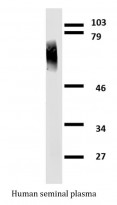ARG62961
anti-ApoJ / Clusterin antibody [Hs-3]
anti-ApoJ / Clusterin antibody [Hs-3] for ELISA,ICC/IF,IHC-Formalin-fixed paraffin-embedded sections,Western blot and Human
Cancer antibody; Cell Biology and Cellular Response antibody; Immune System antibody; Metabolism antibody; Signaling Transduction antibody
概述
| 产品描述 | Mouse Monoclonal antibody [Hs-3] recognizes ApoJ / Clusterin |
|---|---|
| 反应物种 | Hu |
| 不反应物种 | Bov, Cat, Dog, Pig |
| 应用 | ELISA, ICC/IF, IHC-P, WB |
| 宿主 | Mouse |
| 克隆 | Monoclonal |
| 克隆号 | Hs-3 |
| 同位型 | IgG1 |
| 靶点名称 | ApoJ / Clusterin |
| 抗原物种 | Human |
| 抗原 | Freshly ejaculated human sperms were washed in PBS and extracted in 3% acetic acid, 10% glycerol, 30 mM benzaminidine. The acid extract was dialyzed against 0.2% acetic acid and subsequently used for immunization. |
| 偶联标记 | Un-conjugated |
| 別名 | Clusterin; Apolipoprotein J; SGP-2; SP-40; APOJ; ApoJbeta; CLU2; CLU1; NA1/NA2; TRPM2; CLI; SGP2; Apo-J; TRPM-2; ApoJalpha; Aging-associated gene 4 protein; APO-J; Complement cytolysis inhibitor a chain; Ku70-binding protein 1; Complement cytolysis inhibitor b chain; Testosterone-repressed prostate message 2; Complement-associated protein SP-40,40; KUB1; AAG4; Complement cytolysis inhibitor |
应用说明
| 应用建议 |
|
||||||||||
|---|---|---|---|---|---|---|---|---|---|---|---|
| 应用说明 | * The dilutions indicate recommended starting dilutions and the optimal dilutions or concentrations should be determined by the scientist. | ||||||||||
| 阳性对照 | WB: Seminal plasma IHC-P: Sertoli cells |
属性
| 形式 | Liquid |
|---|---|
| 纯化 | Purified from ascites by protein-A affinity chromatography. |
| 纯度 | > 95% (by SDS-PAGE) |
| 缓冲液 | PBS (pH 7.4) and 15 mM Sodium azide |
| 抗菌剂 | 15 mM Sodium azide |
| 浓度 | 1 mg/ml |
| 存放说明 | For continuous use, store undiluted antibody at 2-8°C for up to a week. For long-term storage, aliquot and store at -20°C or below. Storage in frost free freezers is not recommended. Avoid repeated freeze/thaw cycles. Suggest spin the vial prior to opening. The antibody solution should be gently mixed before use. |
| 注意事项 | For laboratory research only, not for drug, diagnostic or other use. |
生物信息
| 数据库连接 | |
|---|---|
| 基因名称 | CLU |
| 全名 | clusterin |
| 背景介绍 | Clusterin (APO J, SGP-2, TRPM-2, SP-40, pADHC-9, CLJ, T64, GP III, XIP8) is a 75-80 kD disulfide-linked heterodimeric protein containing about 30% of N-linked carbohydrate rich in sialic acid but truncated forms targeted to the nucleus have also been identified. It is a conserved secreted glycoprotein expressed by a wide range of tissues and being implicated in many physiological processes, including e.g. lipid transportation, complement inhibition, tissue remodeling, membrane recycling, or clearence of cellular debris. It is nearly ubiqitously expressed in most mammalian tissues and can be found in plasma, milk, urine, cerebrospinal fluid and semen. Clusterin is able to bind and form complexes with numerous partners (immunoglobulins, lipids, heparin, bacteria, complement components, paraoxonase, beta amyloid, leptin etc.) and is expressed in many pathological and clinically relevant situations including cancer, organ regeneration, infection, Alzheimer disease, retinitis pigmentosa, myocardial infarction, renal tubular damage, autoimmunity and others. A genuine function of clusterin is still enigmatic. |
| 生物功能 | Isoform 1 functions as extracellular chaperone that prevents aggregation of nonnative proteins. Prevents stress-induced aggregation of blood plasma proteins. Inhibits formation of amyloid fibrils by APP, APOC2, B2M, CALCA, CSN3, SNCA and aggregation-prone LYZ variants (in vitro). Does not require ATP. Maintains partially unfolded proteins in a state appropriate for subsequent refolding by other chaperones, such as HSPA8/HSC70. Does not refold proteins by itself. Binding to cell surface receptors triggers internalization of the chaperone-client complex and subsequent lysosomal or proteasomal degradation. Secreted isoform 1 protects cells against apoptosis and against cytolysis by complement. Intracellular isoforms interact with ubiquitin and SCF (SKP1-CUL1-F-box protein) E3 ubiquitin-protein ligase complexes and promote the ubiquitination and subsequent proteasomal degradation of target proteins. Promotes proteasomal degradation of COMMD1 and IKBKB. Modulates NF-kappa-B transcriptional activity. Nuclear isoforms promote apoptosis. Mitochondrial isoforms suppress BAX-dependent release of cytochrome c into the cytoplasm and inhibit apoptosis. Plays a role in the regulation of cell proliferation. [UniProt] |
| 研究领域 | Cancer antibody; Cell Biology and Cellular Response antibody; Immune System antibody; Metabolism antibody; Signaling Transduction antibody |
| 预测分子量 | 52 kDa |
| 翻译后修饰 | Isoform 1 is proteolytically cleaved on its way through the secretory system, probably within the Golgi lumen. Polyubiquitinated, leading to proteasomal degradation. Heavily N-glycosylated. About 30% of the protein mass is comprised of complex N-linked carbohydrate. |
检测图片 (1) Click the Picture to Zoom In








